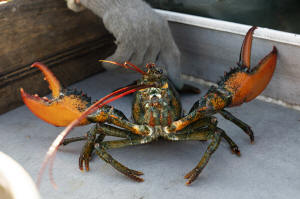US lobster catch drops as crustaceans migrate to colder Canadian waters
[March 01, 2025] By
PATRICK WHITTLE
SCARBOROUGH, Maine (AP) — The U.S. lobster industry's catch keeps
sliding as fishermen contend with the northward migration of the
valuable crustaceans.
The industry is based mostly in Maine, where lobsters are both a
cultural signifier and the backbone of the coastal economy. The state's
haul of lobsters has declined every year from 2021, when it was nearly
111 million pounds, to 2023, when it was less than 97 million pounds.
That decline extended into 2024, when the haul was about 86.1 million
pounds, according to data released by state regulators on Friday. That
is the lowest figure in 15 years. A series of major storms that damaged
waterfront communities and disrupted fisheries was a key factor in the
reduced catch, officials said.
Gov. Janet Mills, a Democrat, praised the industry for its perseverance.
“During a year shaped by unprecedented storms and damage to our working
waterfronts, Maine’s commercial fishermen, aquaculturists, and seafood
dealers once again delivered a major economic benefit to our state,” she
said.
Last year’s catch was still historically high, as Maine fishermen never
exceeded 80 million pounds prior to 2009. Hauls in the 2000s were
typically between 50 million and 80 million pounds. Hauls in the
mid-2010s were routinely above 120 million pounds.

The fishery remained economically strong in 2024. Maine fishermen took
home more than $528 million at the docks, and that was the highest total
since 2021, state officials said. Demand for the product, one of the
most expensive seafoods, remained high, and the price per pound was one
of the highest on record.
The state is meeting the challenges of climate change head-on, said
Patrick Keliher, the commissioner of the Maine Department of Marine
Resources. The governor has secured funding to "help rebuild damaged
coastal infrastructure, make it more resilient to the effects of climate
change, and protect critically important waterfront access for those who
make a living on the water,” he said.
[to top of second column] |

A lobster rears its claws after being caught off Spruce Head, Maine,
Aug. 31, 2021. AP Photo/Robert F. Bukaty, File)
 But numerous environmental and
economic challenges threaten the industry's future. One of the
biggest is the decline in the number of baby lobsters settling off
New England. The young lobsters have to take shelter and grow to
legal size to sustain the future of the fishery. Scientists have
said the lobster population is migrating north to cooler habitats as
oceans warm.
The Maine lobster industry is also linked to Canada’s seafood
industry and could be disrupted by new tariffs. Canadian fishermen
harvest the same species of lobster as American fishermen, and much
of the processing capacity for the seafood is in Canada. Tariffs are
likely to increase prices on both sides of the border, members of
the industry have said.
Another major challenge is the possibility of new rules to protect
critically endangered North Atlantic right whales, which are
vulnerable to entanglement in commercial fishing gear. Fishing
groups have engaged in protracted court cases against the government
over stricter fishing rules.
Other states, including Massachusetts, Rhode Island and New
Hampshire, also have lobster fishing industries, but Maine's is by
far the largest, and the size of the Maine harvest gives a firm
indication of the health of the American lobster industry at large.
Maine accounted for about 78% of the country's total lobster haul in
2023.
All contents © copyright 2025 Associated Press. All rights reserved
 |